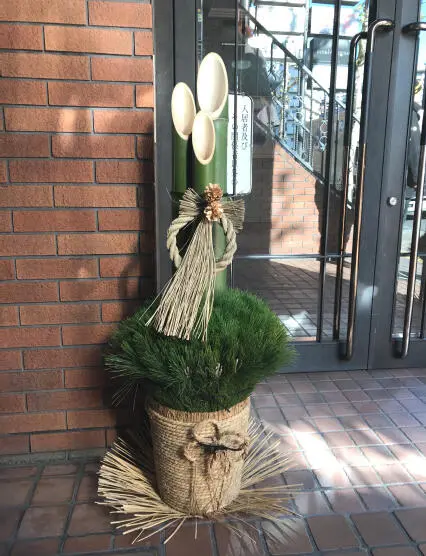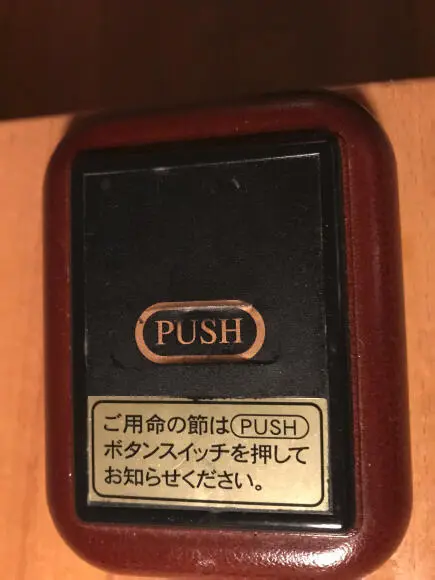
What is standing in front of this house entrance?
This is a typical home decoration that can be seen anywhere in Japan from the end of December to the seventh of January. It serves to greet the spirits of the ancestors and benevolent gods.
Traveler, when planning a trip to Japan you should carefully consider, if you want to do this at the turn of the year. Tokyo is a vibrant, cosmopolitan city, an oversized gourmet temple and a shopper's paradise? Yes, but...
Sometimes visitors read in guidebooks that New Year is the most important holiday of the year. The experienced travelers may think that this is interesting, but he does not need to care any further, because also on the numerous other public holidays in the year everything goes its well-lived course in Tokyo. However, celebrations around the beginning of the year are an extreme exception. Even big designer brands have closed down, every better restaurant closes for about a week, and even fast-food restaurants, dry cleaners, gyms and bars have a few days off. In short, Tokyo is in an annual state of deep sleep as everyone tries to travel back to their homeland to spend a few quiet days with the whole family coming from all directions. Many companies close for about a week and also the employees of smaller companies want to have a holiday. Of course, long-distance trains and planes are fully booked in advance.
There are countless New Year customs, which you absolutely must follow and you have to eat the New Year's food, in order to be lucky in the New Year.
The door decoration in the photo is called Kadomatsu (Door of Pine) and should greet the spirits of the ancestors, and thank the gods for the harvest. It stands as a couple to the right and left of the entrance and embodies husband and wife.
It is very important to greet everyone you meet for the first time in the New Year: Akemashite omedetou gozaimasu. Kotoshi mou yoroshiku onegai shimasu (Happy New Year, please treat me well again). As this is too long and too formal among friends, cool short versions are created, such as: Akeome kotoyoro.

What are you supposed to do?
Unfortunately, this hint, which is for tourists, is not as clear as it should be for everyone: It asks to throw the used toilet paper into the toilet and not into the wastebasket.
If you meet a foreigner in Japan with a large water stain on clothing, he may have become a victim of a toilet. Pictograms are great, as long as their meaning is clear. Unfortunately, some signs are not understood by all cultures. Since many tourists cannot interpret the signs correctly on the keyboards of the toilets, they often test their function for safety's sake once they are in front of the toilet with the result described above. This problem has been investigated by the toilet manufacturers by a survey and in 2017, the leading companies decided to unify the symbols on the toilets. There was a big press conference in which ten seasoned Japanese managers held a sign with the new toilet symbols smiling friendly into the camera. Anyone who does not know the characters of the flush for "big" and "small" should now be led to the flush button with a large and small water vortex. Honestly, these signs are rather reminiscent of wind.
There are many other symbols that should be changed for the better understanding for visitors. Overall, the renewal of 90 characters has already been considered. The new proposal for the sign Onsen (hot spring) also seems a little bizarre: So far this was characterized by three curved lines in a kind of tub. Now the silhouettes of three people are supposed to be added. Initial surveys expressed the opinion that the old sign looked like a noodle soup and the new like noodle soup with people in it. The resistance to change the old sign is also great amongst the Japanese population. In this case finding a new sign has not been successful yet.
As a student of the Japanese language, the same question arises as in the photo: "Why is a large red circle painted across my entire Japanese homework?" I hope this question arises as often as possible, because then the task is solved correctly. Unfortunately, students coming from the west probably are not pleased because they do not know the meaning of the sign. The cross means Batsu (no / bad) and the circle means Maru (yes / good). You can find these two signs amongst others as emojis, which unfortunately only Japanese interpret correctly right away.

What do you do with this button, which is placed on the table in a restaurant?
With this button you can call the service, if you have decided to place an order.
Japanese restaurants are a true hoard of efficiency. This begins when entering the restaurant: you are immediately taken in, asked if you want to sit smoker or non-smoker, how many people come and then you are taken immediately to your place. Once there, you take a seat and get directly the menu. Now you have time to choose something and then call the waiter either with a well audible Sumimasen (sorry) or you find this practical bell button, which you simply press. An employee arrives instantly, picks up the order, repeats it for confirmation and immediately delivers it to the kitchen. Depending on the restaurant, it takes between two minutes to a maximum of 15 minutes till the first dish is served. It is particularly fast with dishes such as curry or noodle soups, because they are already prepared and, for example, only the noodles are freshly cooked. Very often, cooking is done in open kitchens in Japan, so you can see the preparation of your meal. Foods that need to be prepared freshly, such as sushi, tempura (fried vegetables), okonomiyaki (pancakes) or yakitori (grilled skewers) are quick to make and are the Japanese proof that fast food does not have to be classified as inferior quality. Usually guests also eat quickly, then often pay at the exit and leave the restaurant again. Especially when long queues have formed in front of a restaurant, the etiquette demands that you do not stay longer than necessary.
Of course, sometimes Japanese (or foreigners) want to spend a little more time in the restaurant, for example when going out with friends or family you can easily forget the time. In such a case, the waiter might point out that the usual two hours are exceeded and that you should clear the place for the following guests. For the Japanese, this is not a problem, they just move on to the nearest pub or bar. Foreigners often find this regulation, somewhat inappropriate, but many Japanese restaurants need their tables to be occupied several times to make enough revenue.

Why is there a Balinese hotel in the middle of Tokyo?
This is a so-called Love Hotel, which promises Balinese interior design. Here people can rent only hourly rooms from 11:00 am until 11:00 pm.
Do you want the spaceship, the simulated train compartment or rather the Disney version? Tourists often look for a special experience, here you can get it: One stay at an hourly hotel. Sometimes staying at the Love Hotel is the last chance for stranded tourists to find a bed for the night, which is often cheaper than a stay at a regular hotel. The allegedly best love hotels for travelers in Tokyo are even listed on Internet platforms.
Читать дальше
















